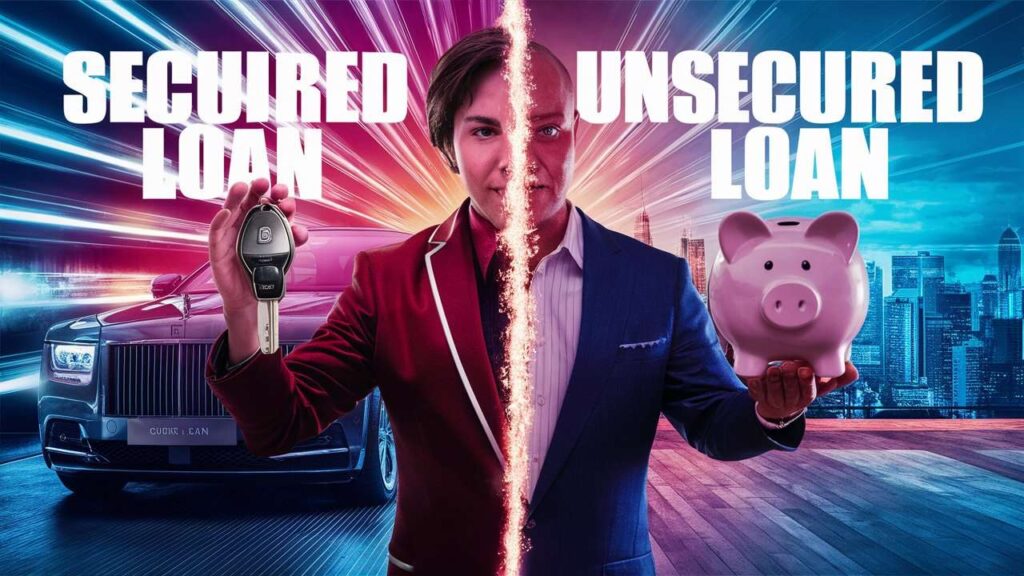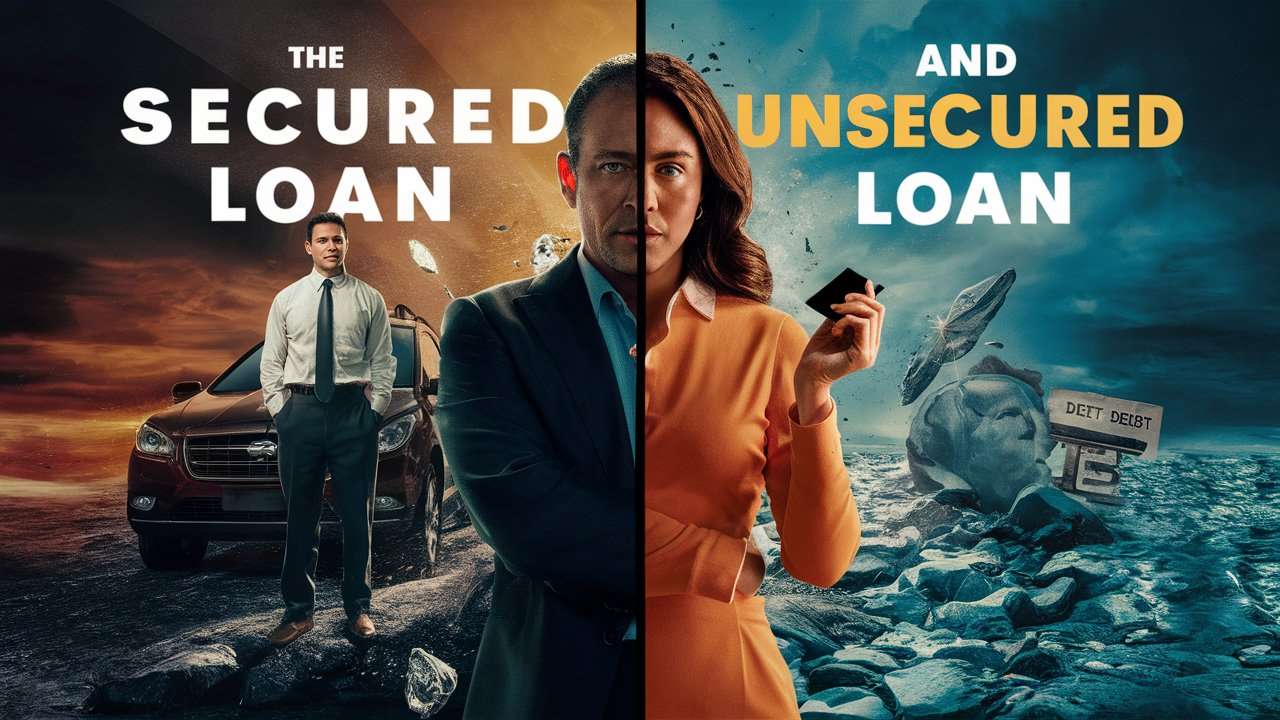The Great Loan Debate
In the grand arena of personal finance, loans often take center stage. They can help you buy a home, fund a dream vacation, or even cover unexpected expenses. But not all loans are created equal.

Why Loans Matter: A Quick Primer
Loans are more than just a way to get money; they’re a powerful financial tool. They can either propel you forward or pull you under, depending on how you wield them. Understanding the difference between secured and unsecured loans is crucial. It can mean the difference between keeping your assets safe or risking them in a pinch.
Secured vs Unsecured: What’s the Buzz?
So, what’s the scoop? Secured loans come with a safety net💸your collateral. Unsecured loans? Not so much. In this post, we’ll explore the nitty-gritty of these two loan types, helping you make an informed decision. Ready? Let’s jump in!
Understanding Secured Loans
What Exactly is a Secured Loan?
A secured loan is a financial agreement backed by collateral, like your home or car. If you default, the lender has the right to seize the asset to recover their losses. It’s a bit like saying, “Hey, I promise to pay you back… but if I don’t, you can take my shiny toy.”
The Collateral Connection: What You Need to Know
Collateral is the magic word here. It’s what gives lenders peace of mind. By putting up an asset, you’re essentially saying, “I’ve got skin in the game!” This often leads to lower interest rates. But, tread carefully💸if you miss payments, that shiny toy could be out the door!
Pros and Cons of Secured Loans: The Good, the Bad, and the Ugly
The Good: Lower interest rates and higher borrowing limits make secured loans attractive.
The Bad: The risk of losing your collateral can cause sleepless nights.
The Ugly: Life happens. Illness or job loss can turn those payments into a financial nightmare.

Unpacking Unsecured Loans
What is an Unsecured Loan?
Unsecured loans are just what they sound like💸loans that don’t require collateral. Think of them as a leap of faith from both the borrower and lender. You get money based on your creditworthiness and promise to pay it back. No assets involved, just your good name!
No Collateral, No Problem: How It Works
With no collateral, lenders rely heavily on your credit score and financial history. If you’ve been a good little borrower, you might score a nice loan. If not, well, they might just look the other way.
Pros and Cons of Unsecured Loans: The Bright Side and the Downside
The Bright Side: Flexibility is the name of the game! You can use the funds for anything from consolidating debt to funding a wedding.
The Downside: Higher interest rates and stricter qualification criteria can be daunting. Plus, missing payments could hurt your credit score💸yikes!

Secured Loans: The Deets You Need
Common Types of Secured Loans: From Mortgages to Auto Loans
Secured loans come in various flavors. Mortgages, car loans, and home equity lines of credit (HELOCs) are the usual suspects. Each type has its quirks, but they all share one common thread: collateral.
Interest Rates and Terms: What to Expect
Expect lower interest rates with secured loans because the lender has a safety net. Terms can vary widely, from short-term loans for cars to 30-year mortgages. Always read the fine print!
Risk Factor: Losing Your Collateral💸Yikes!
The biggest risk? Losing your collateral if you default. Imagine coming home to find your car missing because you missed a payment. It’s a reality check that can hit hard.

Unsecured Loans: The Lowdown
Types of Unsecured Loans: Personal Loans, Credit Cards, and More
Unsecured loans come in many forms💸personal loans, student loans, and credit cards are just a few. They’re designed to fit different needs, so pick wisely!
Interest Rates and Terms: How They Stack Up
Interest rates on unsecured loans tend to be higher because the lender has no collateral to fall back on. Terms usually range from a few months to several years, depending on the type of loan and the lender.
The Risk of Higher Rates: Is It Worth It?
The higher interest rates might make you flinch, but they come with fewer risks💸no collateral means no losing your belongings. Just be sure to budget for those payments!
The Key Differences: Secured vs Unsecured
Collateral: Why It’s a Big Deal
Collateral is the main differentiator. Secured loans require it, while unsecured loans do not. The presence or absence of collateral changes everything💸from interest rates to risk profiles.
Interest Rates: Who Gets the Better Deal?
Secured loans typically offer better interest rates, making them more appealing for larger amounts. Unsecured loans might be pricier, but they offer peace of mind in terms of risk.
Loan Amounts: How Much Can You Borrow?
Secured loans often allow for larger loan amounts, thanks to collateral. Unsecured loans might have lower limits, reflecting the lender’s higher risk.

Choosing Between Secured and Unsecured Loans
Assessing Your Financial Situation: What to Consider
Before making a choice, assess your financial health. Are you stable enough to manage a secured loan’s risks? Or do you prefer the flexibility of an unsecured loan?
Risk Tolerance: How Much Are You Willing to Gamble?
Consider your comfort level with risk. If you’re not keen on losing an asset, an unsecured loan might be your best bet. But if you’re comfortable with collateral, the benefits of a secured loan can be enticing.
Long-Term Goals: What Do You Want to Achieve?
Think about your long-term financial goals. Are you looking to build credit, purchase a home, or pay for education? Your objectives can guide your decision.

When to Opt for a Secured Loan
Ideal Situations for Secured Loans: Who Benefits?
Secured loans shine when you need a large sum of money💸like buying a house or car. If you have valuable collateral, this option can save you money in the long run.
Tips for Securing the Best Rates
Do your homework! Shop around, compare rates, and negotiate where possible. A good credit score can also help you snag better terms.
When to Choose an Unsecured Loan
Ideal Scenarios for Unsecured Loans: Flexibility at Its Finest
Unsecured loans are ideal for smaller amounts, like consolidating debt or covering unexpected expenses. If you want flexibility without the risk of losing your assets, this is the way to go!
Tips for Getting Approved: What Lenders Look For
Lenders look for solid credit scores, stable income, and a good financial history. Be prepared to show off your financial credentials!

Common Misconceptions About Loans
Myth-Busting: Debunking Secured and Unsecured Loan Myths
There’s a lot of misinformation out there. For example, not all secured loans are risky! They can be great tools when used correctly.💸
The Reality Check: What You Should Know
Both types of loans have their place in the financial world. Understanding the facts can help you make the best choice for your situation.💸
Navigating the Loan Process
Application Steps: What to Expect
Whether you’re going for a secured or unsecured loan, the application process is similar. Expect to provide personal and financial information, and be ready for some paperwork.
Approval Criteria: Secured vs Unsecured
Approval criteria differ significantly. Secured loans might require asset valuation, while unsecured loans focus more on creditworthiness. Know what to prepare for!💸
Conclusion: Making the Right Choice for You
Recap of the Key Differences
Secured loans require collateral, usually come with lower rates, and allow for larger amounts. Unsecured loans are more flexible, carry higher rates, and don’t involve assets.
Final Thoughts: Choose Wisely for Your Financial Future
In the end, the right choice depends on your financial situation and goals. Whether you opt for a secured or unsecured loan, knowledge is power.💸
Call to Action: Ready to Dive In?
For more information, explore resources on loan types and financial planning. Consulting a financial advisor can also provide tailored advice to help you navigate your options. Because everyone deserves a financial game plan!
People Also Ask
What is secured loan and unsecured loan with examples?
Secured loans require collateral, meaning the borrower must pledge an asset (like a house) to secure the loan. For example, a mortgage is a secured loan where the house serves as collateral. Unsecured loans do not require collateral; personal loans are a common example. If you default on an unsecured loan, the lender can’t claim your assets.💸
Which is an example of a secured loan?
A mortgage is a classic example of a secured loan. The home you purchase acts as collateral for the loan. If payments aren’t made, the lender can repossess the house.
Is a secured loan good or bad?
Secured loans can be both good and bad. They often come with lower interest rates and higher borrowing limits, making them attractive. However, the risk of losing your collateral if you default is a significant downside.
What are 2 main advantages of unsecured loan?
Two main advantages of unsecured loans are:
- No Collateral Required: You don’t need to risk any assets, which means your property is safe.
- Faster Processing: Without the need for asset valuation, unsecured loans can often be processed more quickly.
Is unsecured better than secured?
It depends on your financial situation. Unsecured loans offer more flexibility and less risk of losing assets, but they usually come with higher interest rates. Secured loans might be better for larger amounts at lower rates if you’re comfortable with the risk.
Why are unsecured loans more risky?
Unsecured loans are riskier for lenders because they have no collateral to claim if the borrower defaults. This higher risk often leads to higher interest rates for borrowers as lenders seek to mitigate potential losses.
Is an unsecured loan better?
An unsecured loan can be better for individuals who don’t want to risk their assets and need flexibility. However, it’s essential to weigh the higher interest rates and stricter qualification criteria against your needs.
How do secured loans work?
Secured loans work by requiring borrowers to pledge an asset as collateral. The lender evaluates the asset’s value and determines the loan amount based on that. If the borrower fails to repay, the lender can seize the collateral to recover losses.
Is a secured loan an asset or liability?
A secured loan is considered a liability because it represents a debt that must be repaid. The collateral backing the loan (like a home) is an asset, but the loan itself is a financial obligation.
What is called unsecured loan?
An unsecured loan is a type of loan that does not require collateral. The lender extends credit based on the borrower’s creditworthiness and ability to repay, relying on their promise to pay back the loan.
Is a car loan secured or unsecured?
A car loan is a secured loan because the vehicle itself serves as collateral. If payments are missed, the lender has the right to repossess the car.
Which is better secured or unsecured loans?
The better option depends on your financial situation and needs. Secured loans typically offer lower interest rates and larger amounts, while unsecured loans provide flexibility without the risk of losing collateral.
What are examples of secured loans?
Examples of secured loans include mortgages, auto loans, and home equity lines of credit (HELOCs). Each of these loans requires collateral tied to the asset being financed.
What is an example of an unsecured debt?
An example of an unsecured debt is a credit card balance. The lender cannot claim any assets if you fail to pay your credit card bill; they can only pursue you for the money owed.
What are the main advantages of an unsecured loan?
The main advantages of an unsecured loan include:
- No Risk of Asset Loss: Borrowers don’t need to put their property at risk.
- Flexible Use of Funds: Unsecured loans can be used for various purposes, from consolidating debt to funding personal projects.











